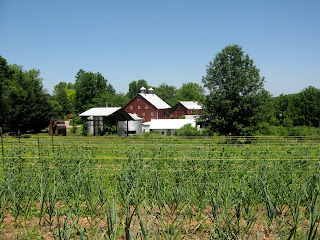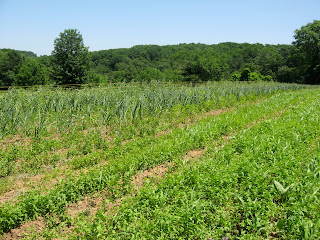 |
| Love Dove Farms, Woodbine, Md. |
John Dove's family is living the story you read about in books. Not the fairy tale kind of story, but the kind highlighted by Michael Pollan and so many others about the plight of the American farmer. A fourth generation farmer in northwestern Howard County, the family's dairy business fell by the wayside a few decades ago, and John's father turned to conventional grain and soy crops to make money. When he could no longer feed a family with four kids by toiling in the fields, he didn't sell their land to a big developer, he got a job. When he's not working the fields, John's dad is delivering fuel. But John's got big dreams for this beautiful farmland and they don't involve Monsanto. John hopes to figure out how to scale an organic sustainable farm to the point he can earn a decent living and be part of changing consumers' choices to a healthier way of life.
Love Dove Farms lies off Old Frederick Road nestled in an expanse of rolling hills of grain fields. Here, John, his father, and grandmother live on about 200 acres that the family has farmed since the early 20th century. That's a significant difference from the majority of organic farmers I know. While most are farming and living in 5-10 acre plots, Love Dove Farms really does have the capacity to scale, if he can work out a healthy ecosystem. So even though this is John's first year selling organically grown produce, he hasn't started small. We toured his three large plots together, and I was impressed by the quantity and variety of plants he's got in the ground. Several long rows of garlic, their scapes and browning foliage indicating he'll soon be pulling hundreds of bulbs from the ground. There are, of course, all of the usual suspects: heirloom tomatoes, radishes, various greens, potatoes, peas, peppers, and herbs. But there are also blueberry bushes, as well as several rows of asparagus, and he's trying his hand at organically grown chick peas. The magnitude is huge when you consider he's doing it almost entirely alone.
 | |
| Looky at all that organic asparagus! |
 |
| This is what 40lbs of garlic plants look like -wow |
|
Besides coming from a family of farmers, John earned a degree in environmental science, and he's interned as part of the Young Farmer's program. While still in college, he interned with Serpent Ridge winery, a fabulous Maryland winery out of Westminster. Last year, he worked for
Calvert's Gift Farm, a 5-acre organic farm in Sparks, Md. that has proven they can provide for a lot of families without a lot of land. Since 2009, they have sponsored a
New Farmer's Training Program with the University of Maryland with the goal of increasing the number of young farmers, particularly in Baltimore County. There he learned a lot of tricks of the trade, including hand methods for working the soil and maintaining an organic farm.
One of the huge challenges he and other small organic farmers face is how to manage the heavy physical demands of many organic practices while producing and selling enough to keep afloat. The hourly wage of farmers using all manual practices is extremely low. John talked about an organic farm in Salsbury he visited recently, where they have incorporated some technologies that help reduce the manual labor. At that farm, they have also integrated produce and livestock into a holistic system. John finds that very appealing. We walk down one of the many long rows of tomatoes , and I ask whether he rips the buds of arterial shoots - side shoots that grow at the join with the main vine. Ideally you want to cut all these off so that your tomato plant puts its energy into producing fruit. The trouble with this is as summer begins, tomatoes grow like crazy, and if you don't grab these shoots quickly, they'll be thick stems in a few days. In other words, it's very man intensive. As we walk along pinching plants, we both agree it'll be nearly impossible for him to do this for his plot through the season. That's the difference, or a difference, in garden scale and farm scale.
 |
| Love Dove Farms - a look over the main field |
|
In this first year of business, John is selling at a few farmers' markets and restaurants. On Friday, he is at the Howard County Hospital market in Columbia from 2-6 pm. This small market offers a nice variety of produce and baked goods, as well as local cheese and coffee. On Saturday, he is trekking south toward D.C. to sell at the Mt. Rainier market. He's also made deals to sell to
Aida Bistro, a yummy Italian wine bar in Columbia, and to
Drovers Wine and Grill in Mount Airy. I've always found Aida excellent and love their dedication to locally sourcing their foods. Drovers is not a place I'm familiar with, but they sell only Maryland wine. I look forward to checking it out. Another dream of his is to sell at Centennial Lake in Columbia on the weekend. What a great idea! If you've ever been there, you know the throngs of health conscious folks who descend on the park to circumnavigate the lake on its paved 2 mile trail or to take a spin on a canoe or paddle boat. I imagine this would be a great setting for farm fresh local produce.
One of my particular soap boxes is that in Central Maryland there is this geographic separation between the bulk of organic consumers and producers. In Carroll County, the number of organic farmers is really quite remarkable. There is a strong enough community of farmers and like-minded individuals in the County to put on the Sustainable Living Maryland (or Go Local) Fair for several years now. This year, the fair had over 1500 visitors, indicating that there is a lot of interest from our residents. But, there is no doubt that Howard County has a much larger consumer base. There are several large organic markets in or adjacent to Howard County, where Carroll County has none. On the other hand, while western Howard County is every bit as agricultural as Carroll County, there really aren't many organic farmers in the area. Several farms are using IPM (integrated pest management), but not many are fully incorporating organic practices. That is why I was so glad to meet John at the market. His story is really quite different from all the other farmers I have interviewed, and I think he's in a great position to realize his dreams of keeping the family farm going organically. Give him a visit and wish him well.